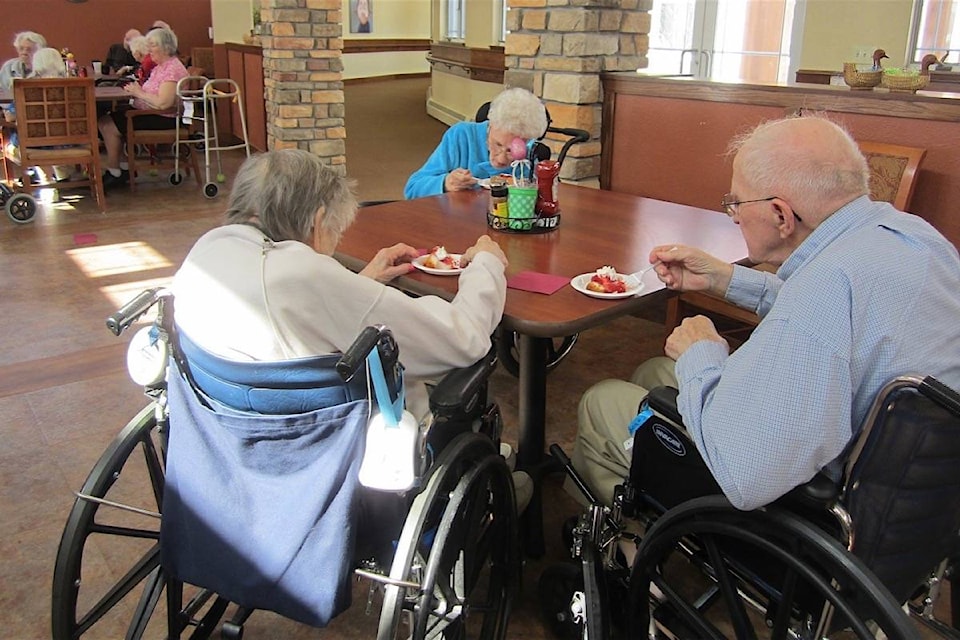The B.C. NDP government has taken its first significant step to close the wide and persistent gap between the reality of basic support for seniors in residential care and the province91������Ƶ�s target.

Officially, that target is an average 3.36 hours of personal care per patient, per day. In practical terms, that means getting two baths a week instead of one, or being escorted with a walker to the dining room instead of being whisked there in a wheelchair by an overworked employee.
In human terms, it means an isolated, lonely senior is not just cleaner and more comfortable, he or she gets a few more minutes of personal contact to relieve the tedium of confinement and the junk of daytime TV.
B.C.91������Ƶ�s Seniors Advocate, Isobel Mackenzie, reported last week that as of March 2017, that standard was being met in 15 per cent of publicly funded care homes. That91������Ƶ�s up from nine-per-cent compliance the previous year, based on an annual survey of the 293 public and contracted care homes across the province.
The first move was communicated to facility operators in conference calls last week, and will be confirmed in the NDP government budget on Feb. 20. Authorities will be funded to increase their casual and part-time care aide positions to full time as of April 1.
Health Minister Adrian Dix cautions that this is at best a partial solution, even with half of the current workforce in casual and part-time positions. Not all will accept full-time work.
91������Ƶ�To reach the 3.36 [hours target], we91������Ƶ�re told that it will require 900 net new care aides, in a sector where more than a quarter of care aides are over 55,91������Ƶ� Dix told me. 91������Ƶ�So there would be considerable effort just to stay where we are now, and this is going to require a significant number of new care aides.91������Ƶ�
Daniel Fontaine, CEO of the B.C. Care Providers Association, agrees: 91������Ƶ�Moving from casual to full-time is not going to do it.91������Ƶ�
Fontaine has been pushing to expand dual-credit high school courses to get more young people into senior care as a first job, with virtually guaranteed employment even in rural and remote communities. These high school spaces are now mainly focused on male-dominated skilled trades, while popular culture bombards teens with the allure of high-tech careers.
At a residential care conference in Surrey Jan. 26, Dix announced new post-secondary training spaces for care aides. Unfortunately, the government is also embarking on an aggressive expansion of child care, and the labour pool for that is largely the same people.
Fontaine says he91������Ƶ�s hearing regularly from private colleges around B.C. that have vacant health care assistant training spaces now. The fastest solution would be to fill those spaces with immigrants eager to work, but there91������Ƶ�s a problem. Federal immigration authorities won91������Ƶ�t issue work permits unless students train at a public college. So the province wastes money on duplicate public spaces due to Ottawa91������Ƶ�s arbitrary rules.
And of course the shortage of young workers mirrors the vast growth in seniors as baby boomers retire. There are currently 28,000 seniors in publicly funded residential care in B.C., out of an estimated 850,000 people over 65. Total senior population is projected to reach 1.4 million over the next 15 years.
91������Ƶ�But over 75, that number is going to increase by two and a half times in the next 20 years,91������Ƶ� Dix said.
Progress is slowly being made, thanks to the work of the Seniors Advocate91������Ƶ�s office to report this situation to the public and to governments.
Tom Fletcher is B.C. legislature reporter and columnist for Black Press. Email: tfletcher@blackpress.ca
tfletcher@blackpress.ca
Like us on and follow us on .



